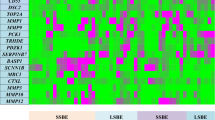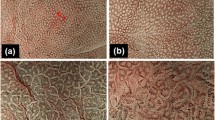Abstract
Background
Barrett’s esophagus with specialized intestinal metaplasia (SIM), which is at high risk of progressing to esophageal adenocarcinoma, has been identified by obtaining biopsy specimens randomly. Magnified endoscopy with narrow band imaging (ME-NBI) is reported to be useful for detecting SIM or the intestinal phenotype. We aimed to evaluate the usefulness of endoscopic brushing followed by ME-NBI for the detection of the intestinal phenotype.
Methods
Biopsy and brushing samples were taken following endoscopic observation by ME-NBI. Total RNA was extracted from the whole sample and microdissected samples, and quantitative reverse transcription-polymerase chain reaction (PCR) analysis of SHH, CDX2, and mucin mRNA expression was performed.
Results
Fifty patients (32 men, 18 women, average age 67.3 years) with metaplastic columnar epithelium of the lower esophagus were studied. MUC2 (85 vs. 65 %) and CDX2 (95 vs. 75 %) were detected more frequently in the brushing samples than in the biopsy samples. MUC2 expression levels were significantly higher in the brushing samples than those in the biopsy samples. CDX2 and MUC2 expression levels in the brushing samples were significantly higher in the mucosa with tubular/villous pattern observed by ME-NBI than the levels in mucosae with other patterns.
Conclusions
Endoscopic brushing in mucosa of columnar epithelium with a tubular/villous pattern visualized by ME-NBI is useful to detect the intestinal phenotype.






Similar content being viewed by others
References
Reid BJ. Barrett’s esophagus and esophageal adenocarcinoma. Gastroenterol Clin North Am. 1991;20:817–34.
Thompson JJ, Zinsser KR, Enterline HT. Barrett’s metaplasia and adenocarcinoma of the esophagus and gastroesophageal junction. Hum Pathol. 1983;14:42–61.
di Pietro M, Fitzgerald RC. Barrett’s oesophagus: an ideal model to study cancer genetics. Hum Genet. 2009;126:233–46.
Wang KK, Sampliner RE. Updated guidelines 2008 for the diagnosis, surveillance and therapy of Barrett’s esophagus. Am J Gastroenterol. 2008;103:788–97.
Sharma P. Recent advances in Barrett’s esophagus: short-segment Barrett’s esophagus and cardia intestinal metaplasia. Semin Gastrointest Dis. 1999;10:93–102.
DeMeester SR, DeMeester TR. Columnar mucosa and intestinal metaplasia of the esophagus: fifty years of controversy. Ann Surg. 2000;231:303–21.
Abrams JA, Kapel RC, Lindberg GM, Saboorian MH, Genta RM, Neugut AI, et al. Adherence to biopsy guidelines for Barrett’s esophagus surveillance in the community setting in the United States. Clin Gastroenterol Hepatol. 2009;7:736–42 (quiz 710).
Macdonald PM, Struhl G. A molecular gradient in early Drosophila embryos and its role in specifying the body pattern. Nature. 1986;324:537–45.
Moreno E, Morata G. Caudal is the Hox gene that specifies the most posterior Drosophile segment. Nature. 1999;400:873–7.
Phillips RW, Frierson HF Jr, Moskaluk CA. Cdx2 as a marker of epithelial intestinal differentiation in the esophagus. Am J Surg Pathol. 2003;27:1442–7.
Silberg DG, Sullivan J, Kang E, Swain GP, Moffett J, Sund NJ, et al. Cdx2 ectopic expression induces gastric intestinal metaplasia in transgenic mice. Gastroenterology. 2002;122:689–96.
Wallace MB, Perelman LT, Backman V, Crawford JM, Fitzmaurice M, Seiler M, et al. Endoscopic detection of dysplasia in patients with Barrett’s esophagus using light-scattering spectroscopy. Gastroenterology. 2000;119:677–82.
Panjehpour M, Overholt BF, Vo-Dinh T, Haggitt RC, Edwards DH, Buckley FP 3rd. Endoscopic fluorescence detection of high-grade dysplasia in Barrett’s esophagus. Gastroenterology. 1996;111:93–101.
Mayinger B, Horner P, Jordan M, Gerlach C, Horbach T, Hohenberger W, et al. Light-induced autofluorescence spectroscopy for the endoscopic detection of esophageal cancer. Gastrointest Endosc. 2001;54:195–201.
Poneros JM, Brand S, Bouma BE, Tearney GJ, Compton CC, Nishioka NS. Diagnosis of specialized intestinal metaplasia by optical coherence tomography. Gastroenterology. 2001;120:7–12.
Kadowaki S, Tanaka K, Toyoda H, Kosaka R, Imoto I, Hamada Y, et al. Ease of early gastric cancer demarcation recognition: a comparison of four magnifying endoscopy methods. J Gastroenterol Hepatol. 2009;24:1625–30.
Nakayoshi T, Tajiri H, Matsuda K, Kaise M, Ikegami M, Sasaki H. Magnifying endoscopy combined with narrow band imaging system for early gastric cancer: correlation of vascular pattern with histopathology (including video). Endoscopy. 2004;36:1080–4.
Uedo N, Ishihara R, Iishi H, Yamamoto S, Yamamoto S, Yamada T, et al. A new method of diagnosing gastric intestinal metaplasia: narrow-band imaging with magnifying endoscopy. Endoscopy. 2006;38:819–24.
Geisinger KR, Teot LA, Richter JE. A comparative cytopathologic and histologic study of atypia, dysplasia and adenocarcinoma in Barrett’s esophagus. Cancer. 1992;69:8–16.
Fusaroli P, Fedeli P, Manta R, et al. Histology vs. brush cytology (BC) in the diagnosis and follow up of Barrett’s esophagus (BE). Gastrointest Endosc. 2005;61:AB131.
Hardwick RH, Morgan RJ, Barren BF, Lott M, Alderson D. Brush cytology in the diagnosis of neoplasia in Barrett’s esophagus. Dis Esophagus. 1997;10:233–7.
Geboes K, Van Eyken P. The diagnosis of dysplasia and malignancy in Barrett’s oesophagus. Histopathology. 2000;37:99–107.
Krishnadath KK. Novel findings in the pathogenesis of esophageal columnar metaplasia or Barrett’s esophagus. Curr Opin Gastroenterol. 2007;23:440–5.
Nusslein-Volhard C, Wieschaus E. Mutations affecting segment number and polarity in Drosophila. Nature. 1980;287:795–801.
van den Brink GR, Hardwick JC, Tytgat GN, Brink MA, Ten Kate FJ, Van Deventer SJ, et al. Sonic hedgehog regulates gastric gland morphogenesis in man and mouse. Gastroenterology. 2001;121:317–28.
van den Brink GR, Hardwick JC, Nielsen C, Xu C, ten Kate FJ, Glickman J, et al. Sonic hedgehog expression correlates with fundic gland differentiation in the adult gastrointestinal tract. Gut. 2002;51:628–33.
Endo T, Awakawa T, Takahashi H, Arimura Y, Itoh F, Yamashita K, et al. Classification of Barrett’s epithelium by magnifying endoscopy. Gastrointest Endosc. 2002;55:641–7.
Goda K, Tajiri H, Ikegami M, Urashima M, Nakayoshi T, Kaise M. Usefulness of magnifying endoscopy with narrow band imaging for the detection of specialized intestinal metaplasia in columnar-lined esophagus and Barrett’s adenocarcinoma. Gastrointest Endosc. 2007;65:36–46.
Norimura D, Isomoto H, Nakayama T, Hayashi T, Suematsu T, Nakashima Y, et al. Magnifying endoscopic observation with narrow band imaging for specialized intestinal metaplasia in Barrett’s esophagus with special reference to light blue crests. Dig Endosc. 2010;22:101–6.
Sharma P, Bansal A, Mathur S, Wani S, Cherian R, McGregor D, et al. The utility of a novel narrow band imaging endoscopy system in patients with Barrett’s esophagus. Gastrointest Endosc. 2006;64:167–75.
Silva FB, Dinis-Ribeiro M, Vieth M, Rabenstein T, Goda K, Kiesslich R, et al. Endoscopic assessment and grading of Barrett’s esophagus using magnification endoscopy and narrow-band imaging: accuracy and interobserver agreement of different classification systems (with videos). Gastrointest Endosc. 2011;73:7–14.
Lin X, Finkelstein SD, Zhu B, Ujevich BJ, Silverman JF. Loss of heterozygosities in Barrett esophagus, dysplasia, and adenocarcinoma detected by esophageal brushing cytology and gastroesophageal biopsy. Cancer. 2009;117:57–66.
Conflict of interest
All authors have no conflict of interest and there were no funding sources for the study, including pharmaceutical and industry support.
Author information
Authors and Affiliations
Corresponding author
Rights and permissions
About this article
Cite this article
Murao, T., Shiotani, A., Yamanaka, Y. et al. Usefulness of endoscopic brushing and magnified endoscopy with narrow band imaging (ME-NBI) to detect intestinal phenotype in columnar-lined esophagus. J Gastroenterol 47, 1108–1114 (2012). https://doi.org/10.1007/s00535-012-0589-9
Received:
Accepted:
Published:
Issue Date:
DOI: https://doi.org/10.1007/s00535-012-0589-9




